Specialist homelessness services clients who have experienced family and domestic violence
Specialist homelessness services (SHS) can provide assistance to people who are experiencing homelessness, or who are at risk of homelessness, including clients who have experienced family and domestic violence. Examining the number of SHS clients who have experienced family and domestic violence provides an indication of the level of service response. Data on people seeking support from SHS agencies are drawn from the AIHW Specialist Homelessness Services Collection. The AIHW Specialist homelessness services annual report includes additional details on Clients who have experienced family and domestic violence.
The visualisation below allows users to explore the number of SHS clients who have experienced family and domestic violence, by sex and state and territory, over time. In Australia, between 2011–12 and 2020–21, the rate of specialist homelessness services clients who have experienced family and domestic violence increased across all states and territories except South Australia for females, and Western Australia, South Australia and Australian Capital Territory for males.
Specialist homelessness services clients who have experienced family and domestic violence, by sex and state and territory, 2011–12 to 2020–21
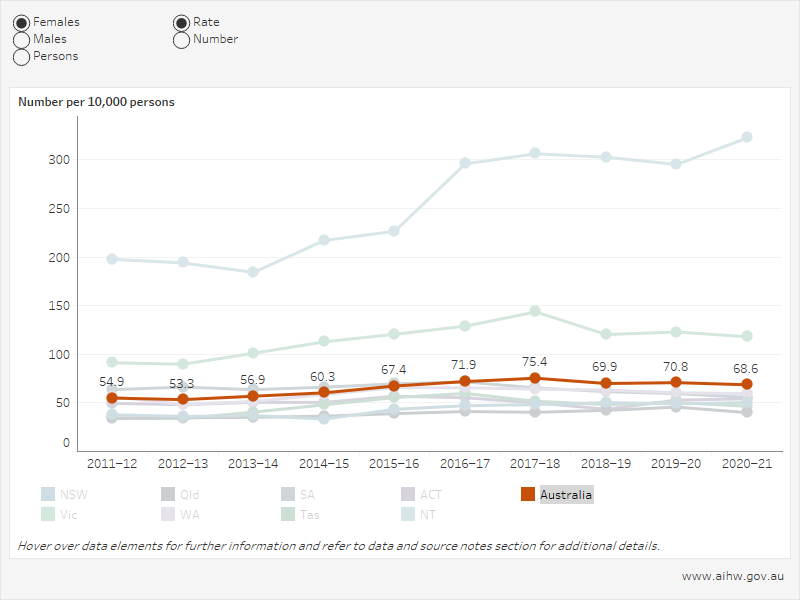
The visualisation below allows users to explore the number of Aboriginal and Torres Strait Islander SHS clients who have experienced family and domestic violence, by sex, over time. Between 2011–12 and 2020–21, the rate of Indigenous specialist homelessness services clients who have experienced family and domestic violence was highest for females and increased over time for both females (58.0% increase) and males (58.7% increase).
Indigenous Specialist homelessness services clients who have experienced family and domestic violence, by sex, 2011–12 to 2020–21
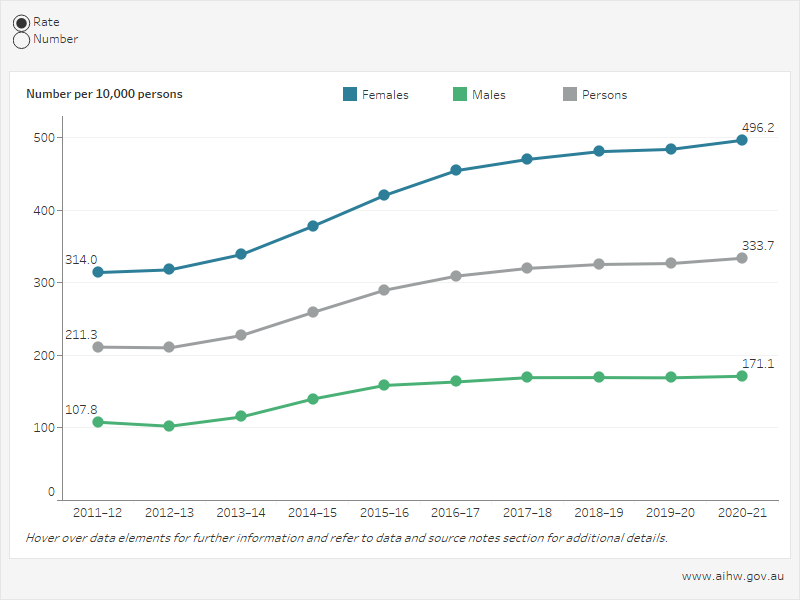
Population groups
Some population groups may be at higher risk of homelessness due to family and domestic violence. Understanding which groups are at higher risk, can be used to inform the development of more targeted programs and services for these clients.
The visualisation below allows users to explore the number of SHS clients who have experienced family and domestic violence, by various population groups. It shows that in 2020–21, rates were highest for all females aged 25–34 and all Indigenous females aged 25–34. For both males and females, the Northern Territory had the highest rate of all states and territories.
Specialist homelessness services clients who have experienced family and domestic violence, for select population groups, 2020–21
Other characteristics
Selected vulnerabilities
People who experience family and domestic violence may experience other vulnerabilities to experiencing homelessness, such as mental health issues and problematic drug or alcohol use.
The visualisation below allows users to explore the proportion of SHS clients who have experienced family and domestic violence and who also experience current mental health issues or problematic drug and/or alcohol use, by sex, over time. In 2020–21, of those aged 10 and over, 4 in 10 (40%) also had a current mental health issue and over 1 in 10 (12% or 10,700) had problematic drug and/or alcohol use.
Between 2011–12 and 2020–21, the proportion of specialist homelessness services clients who have experienced family and domestic violence and had a current mental health issue increased for females and males. Over the same period, the proportion of specialist homelessness services clients who have experienced family and domestic violence and problematic drug/alcohol use increased slightly for females and decreased for males.
Specialist homelessness services clients aged 10 and over who have experienced family and domestic violence, by select vulnerabilities, 2011–12 to 2020–21
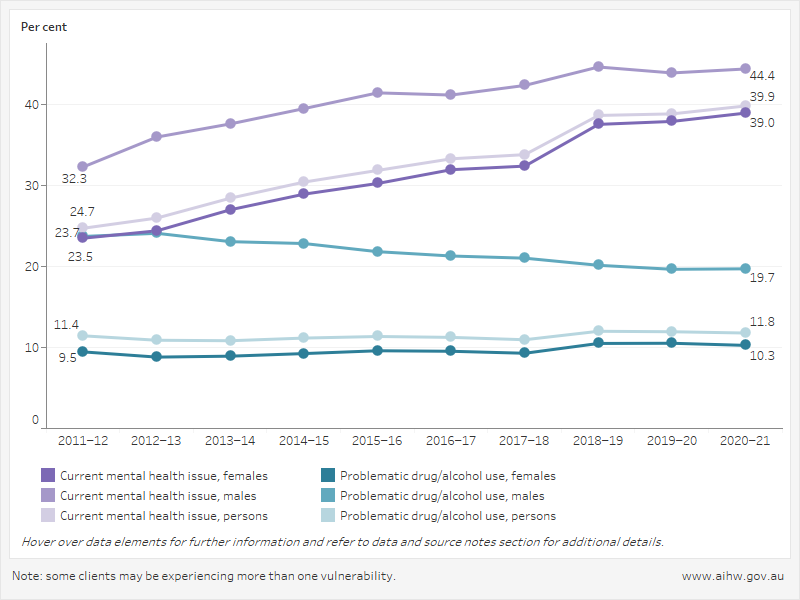
Disability
SHS clients who experience family and domestic violence may also be living with disability.
The visualisation below allows users to explore the proportion of SHS clients who have experienced family and domestic violence and are living with disability, by sex over time. In 2020–21, 1 in 50 (2.1%) SHS clients were living with disability. Between 2013–14 and 2020–21, males had a higher rate than females for all time points.
Specialist homelessness services clients who have experienced family and domestic violence, with disability, by sex, 2013–14 to 2020–21
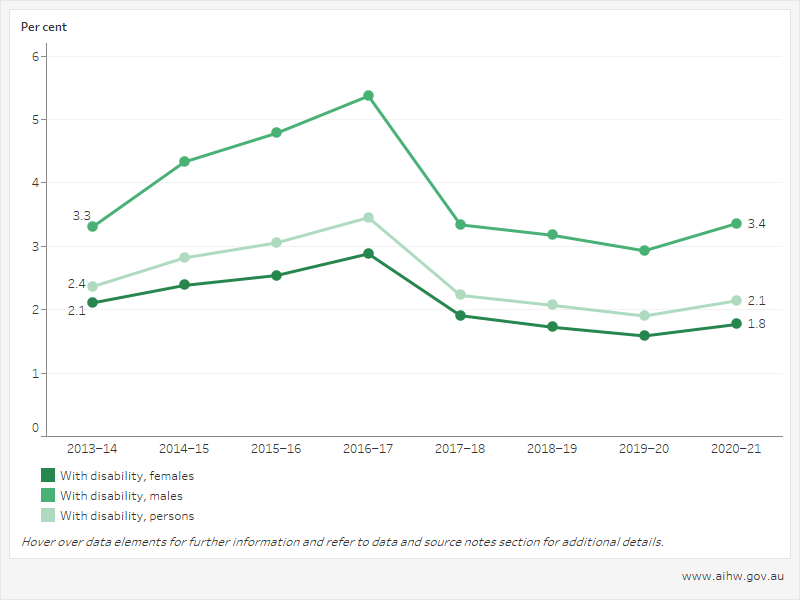
Children
Given the impact of childhood experiences on future development and wellbeing, children accessing specialist homelessness services who have experienced family and domestic violence are a particularly vulnerable group.
The visualisation below allows users to explore SHS clients aged under 18 years who have experienced family and domestic violence who present alone at the beginning of their support, by age group, over time. In 2020–21, the proportion of children who have experienced FDV presenting alone was lower for children aged 0–14 compared with those aged 15–17. Conversely, the proportion of those presenting alone who have experienced FDV was higher among the younger age groups. This pattern was consistent across years.
Specialist homelessness services clients who have experienced family and domestic violence and are presenting alone, by age, 2011–12 to 2020–21
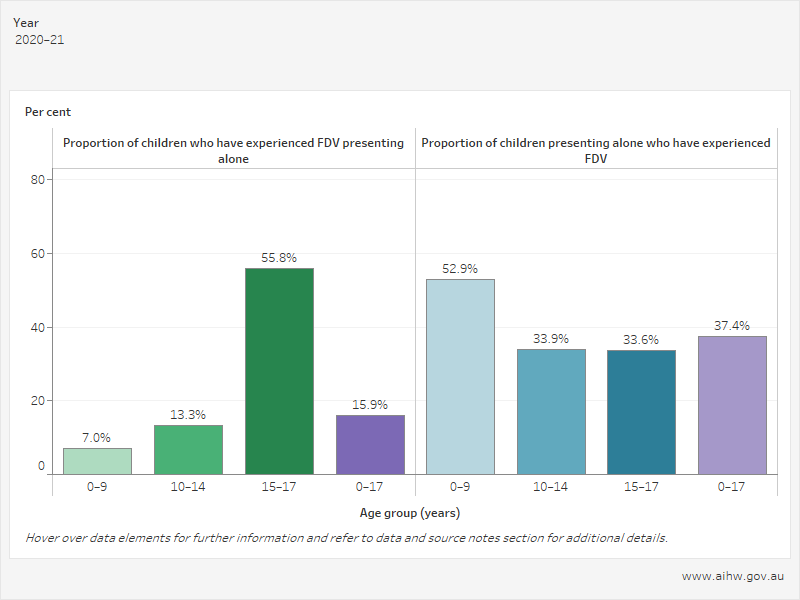
The visualisation below allows users to explore SHS females aged 18 years and over who have experienced family and domestic violence, and present with a child/ren only at the beginning of their support, by age group, over time. In 2020–21, around 2 in 3 (66%) women presenting as single with a child/ren were experiencing family and domestic violence. Proportions were higher for those aged 25–44 compared to younger and older women. Of women who experienced FDV, around 1 in 5 (21%) presented as single with child/ren.
Specialist homelessness services clients who have experienced family and domestic violence and are presenting with a child/ren only, women, by age, 2011–12 to 2020–21
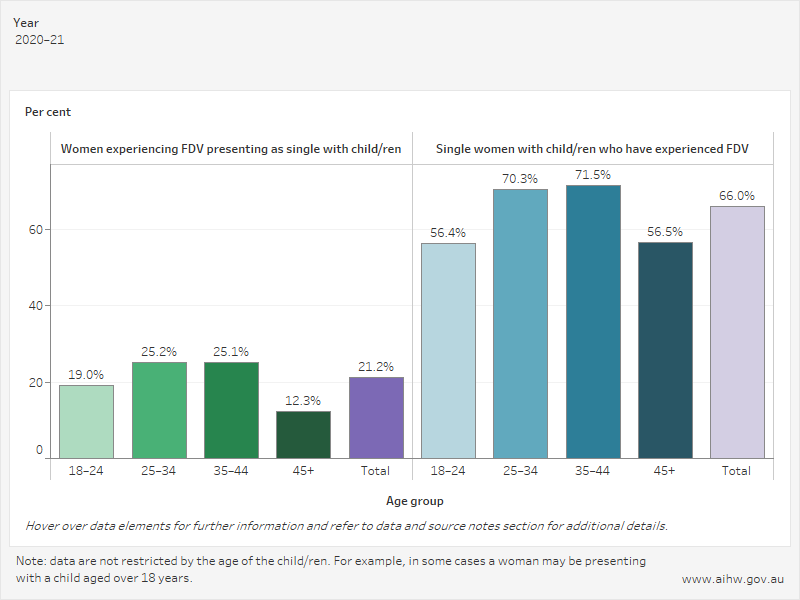
Notes
- A Specialist Homelessness Services Collection (SHSC) client is identified as experiencing family and domestic violence if in any support period during the reporting period the client was formally referred from a non-SHS family and domestic violence agency to an SHS agency, ‘family and domestic violence’ was reported as a reason they sought assistance, or during any support period they required family or domestic violence assistance. The SHSC reports on clients experiencing family and domestic violence of any age, including both victims and a smaller number perpetrators who may be assisted by SHS agencies. Current data do not allow for victims and perpetrators to be reported separately.
- Data for 2011–12 to 2016–17 have been adjusted for non-response. Due to improvements in the rates of agency participation and SLK validity, 2017–18 data are not weighted. The removal of weighting does not constitute a break in time series and weighted data from 2011–12 to 2016–17 are comparable with unweighted data for 2017–18 onwards.
- Support period counts may differ from previous publications due to an improvement in methodology, which has resulted in a small decrease in the number of support periods.
- Data have been extracted from the SHSC data cubes which have undergone confidentialisation. Due to this process, figures may differ from those published in annual SHSC reports.
- From 2017-18 to 2018-19, there was a three per cent decrease in the total number of Victorian homelessness clients and a 10 percent decrease in family violence clients following years of steady increases in these numbers. The decrease was primarily due to a practice correction in how some family violence agencies were recording clients. In addition, during 2018-19, a phased process to shift family violence intake to non-SHS services began, which may result in an overall decrease in the number of SHS family violence clients over the coming years. Caution should be used when comparing Victorian client numbers over recent years.
- Main language spoken at home total excludes clients who only had a support period(s) starting before 1 July 2019, when the main language data item was introduced.
- Specialist Homelessness Services (SHS) clients are identified as having a current mental health issue if they are aged 10 years or older and have provided any of the following information:
- They indicated that at the beginning of support they were receiving services or assistance for their mental health issues or had in the last 12 months.
- Their formal referral source to the SHS was a mental health service.
- They reported ‘mental health issues’ as a reason for seeking assistance.
- Their dwelling type either a week before presenting to an agency, or when presenting to an agency, was a psychiatric hospital or unit.
- They had been in a psychiatric hospital or unit in the last 12 months.
- At some stage during their support period, a need was identified for psychological services, psychiatric services or mental health services.
- The identification of clients with problematic drug and/or alcohol use may be current or recent; referring to issues at presentation, just prior to receiving support or at least once in the 12 months prior to support. SHS clients aged 10 and over are reported in the SHSC with problematic drug and/or alcohol use if, at the beginning of or during support, the client provided any of the following information:
- recorded their dwelling type as rehabilitation facility
- required drug or alcohol counselling
- were formally referred to the SHS service from an alcohol and drug treatment service
- had been in a rehabilitation facility or institution during the past 12 months
- reported problematic drug, substance or alcohol use as a reason for seeking assistance or the main reason for seeking assistance.
- SHSC clients living with a disability reported that they have a limitation in core activities (self care, mobility and communication) and always or sometimes needed assistance with one or more of these core activities. These clients are described as having severe or profound core activity limitation, or as living with disability.
- The proportion of clients living with disability is calculated for all clients who experienced family and domestic violence, including those with “not stated” responses to disability questions.
- People presenting alone are defined as any client whose presenting unit type is recorded as ‘lone person’ by a SHS agency in their first support period in the financial year. Data for presenting unit type may not be comparable across age groups due to differences in interpretation of presenting units and how they are recorded. This issue mainly concerns young children and presenting unit type ‘lone person’. Presenting unit type is not necessarily the same as living arrangement.
- States and territories have varying policies on SHS agencies directly supporting children presenting alone, which may affect the data shown here.
- Data for women who presented as single with child/ren are not restricted by the age of the child/ren. For example, in some cases a woman may be presenting with a child aged over 18 years.
- For more information see Methods, Glossary and Data sources.
Source
AIHW Specialist Homelessness Services Collection data cubes 2011-12 to 2020-21


